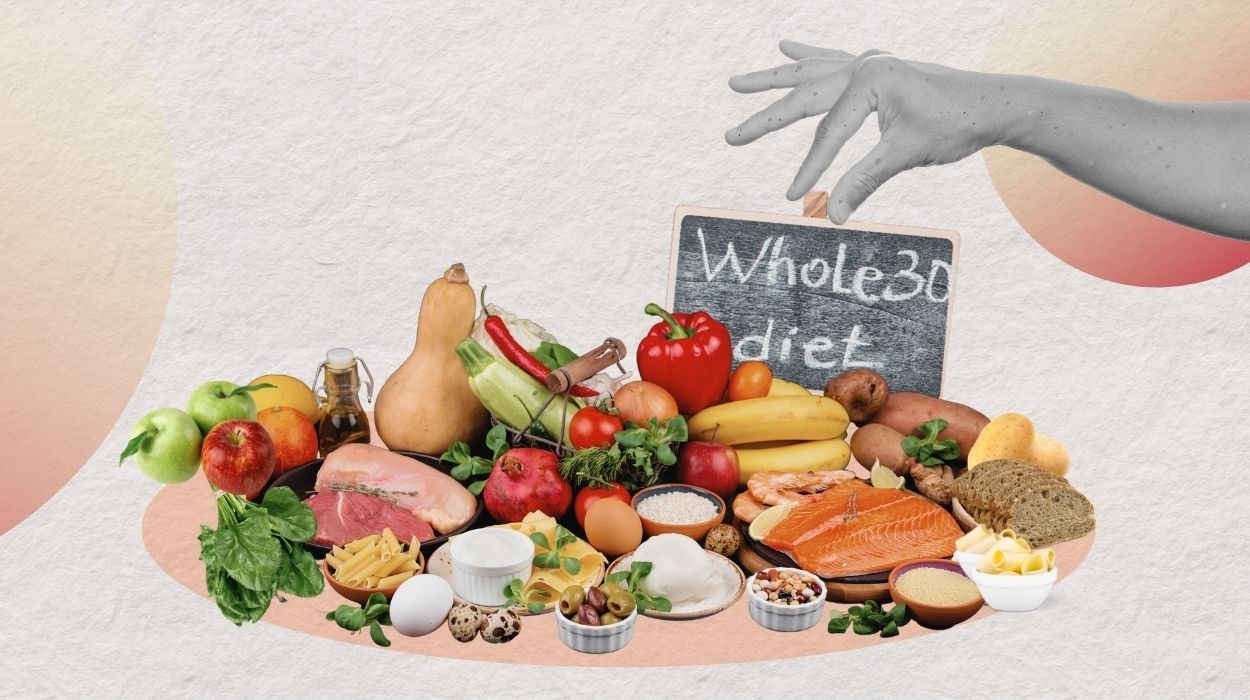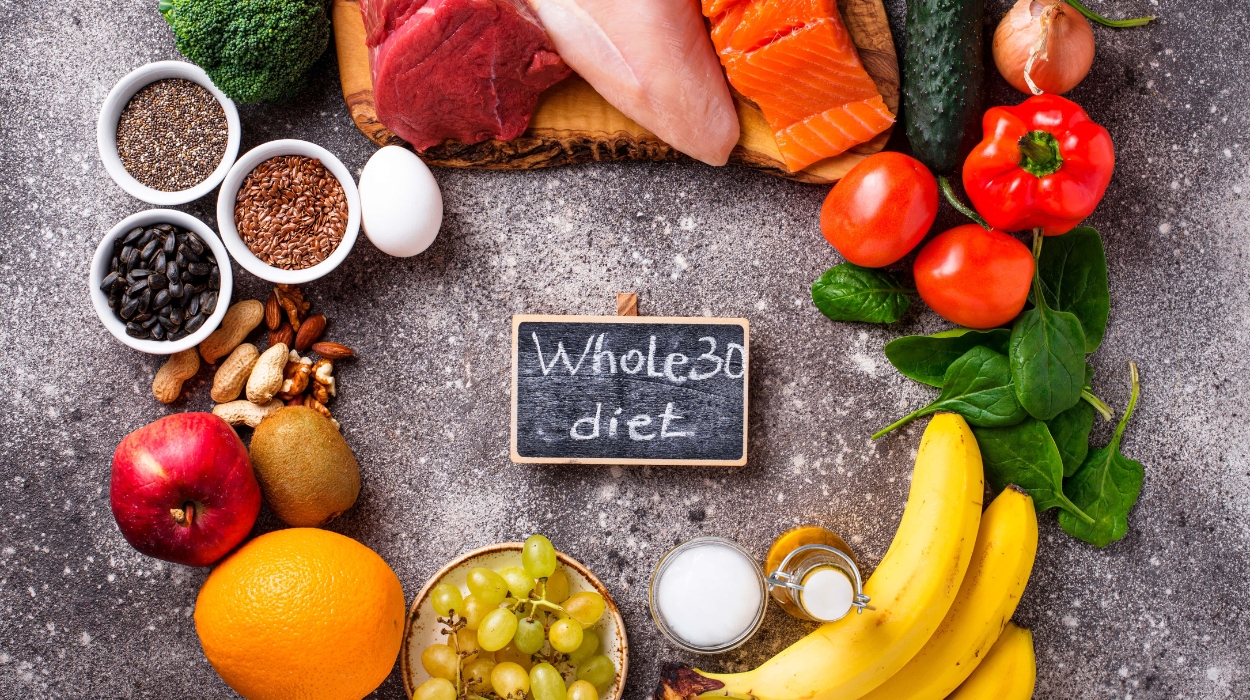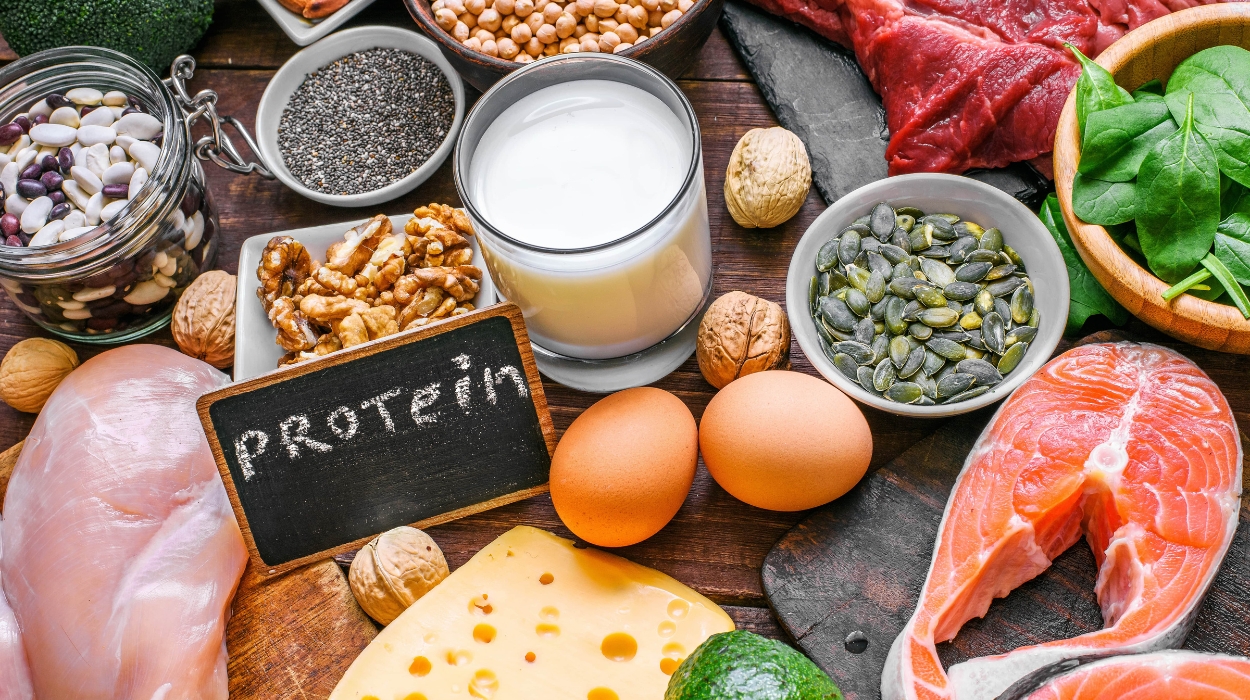 Expert's opinion
Expert's opinion
Expert's opinion
The article is a subjective view on this topic written by writers specializing in medical writing.
It may reflect on a personal journey surrounding struggles with an illness or medical condition, involve product comparisons, diet considerations, or other health-related opinions.
Although the view is entirely that of the writer, it is based on academic experiences and scientific research they have conducted; it is fact-checked by a team of degreed medical experts, and validated by sources attached to the article.
The numbers in parenthesis (1,2,3) will take you to clickable links to related scientific papers.
Whole30 Diet 2024: An Ultimate Guide For Beginners

The Whole30 diet has been gaining popularity in recent years. Many claim this diet has multiple health benefits, including
- Weight loss
- Energy levels
- Improved sleep
- Improved athleticism
The diet’s founders promise that the Whole30 program will change your thoughts about food and taste buds. Proponents of the diet further claim that it can alter your emotional relationship with food and your body.
Whether or not the Whole30 program lives up to these claims is still up for debate. However, making temporary changes to avoid junk food and processed foods can benefit your health. But what is the Whole30 diet? Read on to learn about this elimination diet, the pros and cons, tips, and sample menus.
Whole30 Diet Plan
Whole30 Diet Plan: Sample Meal
Below are some Whole30 meal suggestions for those interested in trying the Whole30 diet.
Day 1: Balanced Bliss (approx. 932 calories)
The “Balanced Bliss” day plan is ideal for those who want to enjoy flavorful, nutrient-dense meals while adhering to the Whole30 guidelines. It provides a balance of macronutrients necessary for energy, muscle building, and overall health, using fresh, whole ingredients to create satisfying and delicious meals.
| Breakfast | |
| Large Eggs | 2 |
| Medium avocado | 1/2 |
| Roasted sweet potatoes | 100g |
| Lunch | |
| Grilled chicken breast | 150g |
| Spinach | 1 cup |
| Diced mango | 100g |
| Diced red onion | 1/4 cup |
| Chopped cilantro | 1 tbsp |
| Lime Juice | 1/2 lime |
| Dinner | |
| Chopped kale | 1 cup |
| Mixed vegetables (carrots, zucchini, bell peppers) | 1 cup |
| Whole30-compliant sausage | 100g |
Day 2: Savory Delight (approx. 1073 calories)
The “Savory Delight” day plan is crafted for those who enjoy a hearty, protein-focused diet. Each meal is designed to be fulfilling and flavorful, incorporating high-quality proteins and fresh produce to create a satisfying and nutritionally balanced day of eating. This plan is ideal for those looking to maintain energy levels, build muscle, and adhere to the Whole30 dietary guidelines.
| Breakfast | |
| Whole30-compliant ham | 2 slices |
| Melon slices | 1 cup |
| Hashbrowns with onions | 1/2 cup |
| Lunch | |
| Large portobello mushrooms | 2 |
| Cooked ground turkey | 200g |
| Taco seasoning (Whole30-compliant) |
| Dinner | |
| Salmon fillet | 200g |
| Sliced bell peppers | 1 cup |
| Medium avocado | 1/2 |
Between meals, snacks help keep hunger at bay and keep you energized.
Whole30-Approved Snacks
- Plantain chips plain or with guacamole
- Celery with nut butter
- Tuna with compatible mayo and pickles
- Trail mix (without peanuts)
- Veggies and a handful of cashews
- Hard-boiled eggs
- Dates stuffed with nut butter
- Coconut yogurt parfaits
- Sprouted pumpkin seeds
What Is The Whole30 Diet?

Photo: Yulia Furman/Shutterstock
Whole30 is a strict elimination diet regimen aiming to improve health and emotional well-being over one month. This diet regimen was created by certified sports nutritionists in 2009, intending to reshape your relationship with food and reset your metabolism.
This program focuses on eliminating sugar, grains, legumes, alcohol, and dairy, which may negatively impact your health.
Removing these foods from your diet is supposed to assist your body in recovering from the adverse effects of foods and promote long-term health by their avoidance.
The goal of this diet is to lose weight, which is why many people follow it. However, it also helps identify problem foods and food intolerances, thus, improving your health.
Whole30 Diet Food List
Whole30 is structured into two phases: a 30-day elimination phase followed by a ten-day reintroduction phase.
During the 30-day elimination phase of the diet, it is recommended that you eat natural, whole foods, including meat, seafood, herbs, spices, and eggs. In addition, you should eat lots of vegetables, fruits, and healthy fats. Remember that this portion of the program is only for 30 days, so don’t be intimidated by the list of foods you need to eliminate.
Below you will find different Whole30 diet food lists, including allowed foods, not allowed foods, snacks, and exceptions.
Whole30 Diet Allows The Following Minimally Processed Whole Foods
Unprocessed Meat
- Beef
- Pork
- Lamb
- Chicken
- Turkey
- Duck
Fish And Seafood
- Shrimp
- Salmon
- Swordfish
- Scallops
- Crab
Vegetables And Fruits
- All fresh and dried fruit
- All vegetables
Nuts And Seeds
- Nut milk
- Nut butter
- Nut flour
- Except for peanuts, which are legumes
Fats
- Avocado oil
- Coconut oil
- Duck fat
- Ghee
- Lard
- Olive oil
- Tallow
Whole30 Diet Does Not Allow Any Of The Following Foods
Sweeteners
- Agave nectar
- Coconut sugar
- Date syrup
- Honey
- Maple syrup
- Monk fruit extract
Artificial Sweeteners
- Equal
- Nutrasweet
- Splenda
- Xylitol
Alcohol
Grains
Including whole grains and gluten-containing grains:
- Barley
- Bulgur
- Corn
- Millet
- Oats
- Rice
- Rye
- Wheat
Beans
- Black
- Black-eyed peas
- Cannellini
- Garbanzo
- Great Northern
- Lima
- Mung
- Kidney
- Pinto
- Red
Peanuts
Soy
- Soy sauce
- Edamame
- Miso
- Soy lecithin
- Soy milk
- Soy protein
- Tempeh
- Tofu
Baked Goods And Treats
Even if they are made with approved ingredients
Foods With Carrageenan Or Sulfites
Specific Foods That Are Not Allowed Include
- Bread
- Biscuits
- Cereal
- Granola
- Muffins
- Pancakes
- Pasta
- Tortillas
- Waffles
- Chips (potato, tortilla, plantain, veggie, etc.)
- French fries
During The Whole30 Elimination, The Following Foods Are Allowed As Exceptions
Ghee Or Clarified Butter
Fruit Juice
Even when used as a natural sweetener, orange, apple, or other 100% fruit juices are compatible with the program.
A Few Legumes Are Permitted
- Green beans
- Snow peas
- Sugar snap peas
- Green peas,
- Yellow peas
- Split peas
Most Kinds Of Vinegar
Apple Cider Vinegar
Balsamic vinegar
Red Wine Vinegar
Rice vinegar
White vinegar
*** Malt-based vinegar is not allowed (it contains gluten)
Coconut Aminos
This natural substitute for soy sauce is allowed even if you notice words like syrup or nectar on the label.
Reintroduction Phase
The second phase of the Whole30 program is the reintroduction phase. In this phase, you slowly add not allowed foods to your diet and monitor how they make you feel. This includes evaluating how the food affects your physical and mental health, metabolism, gut health, immune system, and relationship with food.
The best way to reintroduce not-allowed foods is to add one food group at a time. For example, you could start with gluten the first day after completing the elimination phase of the Whole30 program. Completing a food journal during the reintroduction phase may help you identify symptoms of offending foods. In this phase, add a column called “symptoms” to your food journal.
The Whole30 diet is designed to help your body heal from the inside out. To do this, it eliminates certain food groups that can cause inflammation and other negative symptoms. However, once your body responds and has had a chance to adjust, it’s important to reintroduce these foods slowly and, as stated, one food group at a time. This will help to pinpoint which food groups are causing adverse reactions in your body.
Getting back into a regular dietary routine does not mean you need to reintroduce all foods back into your diet. Some people may decide to only add in the food groups that their bodies respond well to. It is also preferred by the creators not to reintroduce food groups that you did not crave during the elimination portion of the diet.
Tips For Whole30 Diet
Protein

Photo: artem evdokimov/Shutterstock
Often, people do not consume enough protein for their needs, especially in the morning. The amount of protein you need to consume in one day depends on age, activity, and the recommended dietary allowances. On average, this should be around 20% of your daily calories. For example, a 2,000-calorie diet should provide a minimum of 20% calories from protein or 100 grams.
To obtain the recommended amount, try to eat one serving of high-quality protein at each meal. In addition to being highly filling, animal protein is a rich source of vitamins and minerals. Of note, it is essential not to confuse grams of protein with the weight of protein.
Oh, Nuts
The most common reason people complain that they do not see results on their Whole30 rules is that they overeat nuts and/or nut butter. While calories are not monitored on Whole30, if you consume a cup of almond butter each day, you will be adding nearly 1600 calories which adds up quickly considering many women do not need more than 2000 calories per day and men need 2500.
Beware Of Dried Fruit
Whole30 involves changing your relationship with food, which for some, means letting go of your sweet tooth. Sugar addiction cannot be broken by eating multiple servings of dried fruit daily instead of candy. Sugar is present in fruit, and dried fruit contains even more sugar than fresh fruit. Consume no more than two servings of fruit every day.
Fall In Love With Salad

The truth is that lettuce is mainly nutritious water. Additionally, you can add in more foods to increase its nutrition.
Pros Of Whole30 Diet
Some people aren’t suitable for the Whole30 Program, but those who have completed it complement its effectiveness in improving energy levels, mental clarity, and general well-being. Before trying this eating plan, consider the pros and cons.
Nutrient-Dense
Many healthy, nutrient-rich foods are included in the Whole30 plan, including lean proteins, vegetables, fruits, and beneficial fats. As a result, it is common for people on this healthy eating plan to report feeling better physically, mentally, and emotionally.
May Reveal Food Sensitivities
In addition to identifying potential allergies or sensitivities, this diet also allows you to pinpoint foods that trigger your symptoms of distress. It is a clinical, time-honored method for identifying trigger foods and minimizing symptoms by using them.
Restricts Added Sugar And Processed Foods
Experts agree that eliminating added sugars and processed foods from our diet, as Whole30 recommends, can be beneficial. By reducing[1] added sugar intake, inflammation, and illness are reduced, and overall health is improved.
No Restriction On Compliant Foods
Several foods are not allowed on Whole30. However, there are no restrictions on how many of the compliant foods you can eat, which means you can eat as much as you want of these foods without calorie counting.
Neither fruits nor vegetables must be organic, nor must animal protein come from grass-fed animals. No unique products or supplements are required to begin the program, and you do not need to weigh or measure portions. Products eaten should be a variety of unprocessed foods that are high in dietary fiber.
Cons Of Whole30 Diet
Although the claimed benefits of Whole30 may appear very appealing, it is essential to remember that everyone should approach a new diet with caution and moderation. Speak with your doctor or registered dietitian before making significant changes to your diet or lifestyle.
Very Strict
The Whole30 program has some key components that align with a healthy diet. For example, the diet stresses eating minimally processed foods and increasing your intake of fresh fruits and vegetables. However, avoiding nutrient-dense foods like legumes, soy, and dairy may make it more challenging to meet all your daily nutrient needs.
This may create adverse health effects or nutrient deficiencies if you follow Whole30 for more than one month (which is not recommended).
Difficult To Maintain
While strict rules can benefit some people in resetting their eating habits, others may find them ineffective, as restricted diets without indulgences are generally not sustainable.
Those contemplating following this diet long-term should record their meals for a week or two with a column for emotions, one for food, and one for serving size. This type of food monitoring can help ensure your diet provides all the vitamins, minerals, and other nutrients you need daily, and start thinking about how your emotions affect your food intake.
Summary
In the Whole30 program, certain foods are eliminated from the diet that could be causing health concerns for some people. The most common reason people start a Whole30 is to lose weight or to identify foods that cause digestive problems.
The Whole30 diet allows you to eat real food such as meat, vegetables, fruits, nuts, seeds, and healthy natural fats. However, you must avoid the following foods: sugar, grains, legumes, dairy products, alcohol, and highly processed foods. While Whole30 is designed to last only 30 days, it would be difficult, if not impossible, to maintain long-term. In addition, continuing the diet long-term might mean losing some essential nutrients as it is a restrictive eating plan.
+ 1 sources
Health Canal avoids using tertiary references. We have strict sourcing guidelines and rely on peer-reviewed studies, academic researches from medical associations and institutions. To ensure the accuracy of articles in Health Canal, you can read more about the editorial process here
- Rippe, J. and Angelopoulos, T. (2016). Relationship between Added Sugars Consumption and Chronic Disease Risk Factors: Current Understanding. Nutrients, [online] 8(11), p.697. doi:10.3390/nu8110697.



